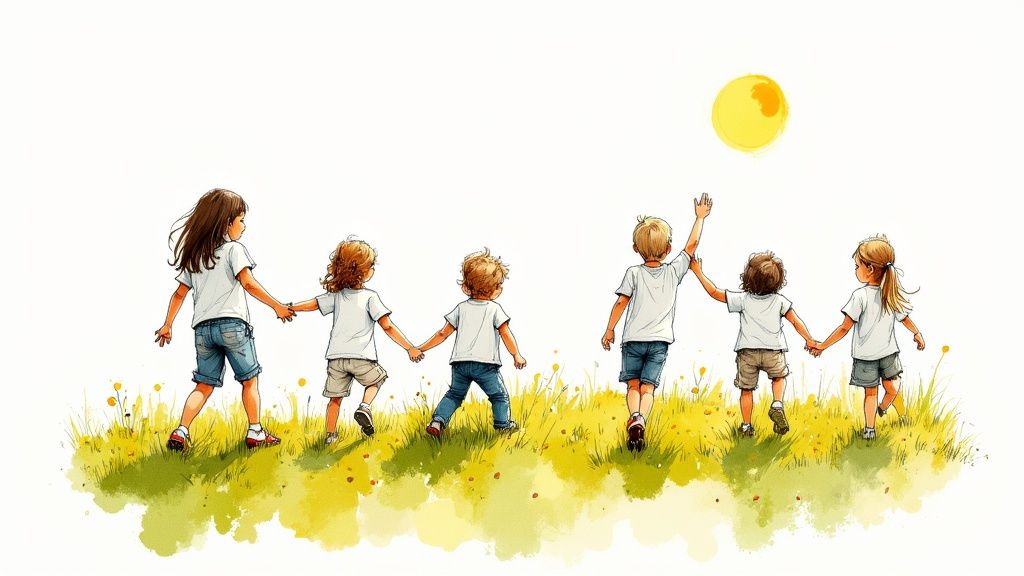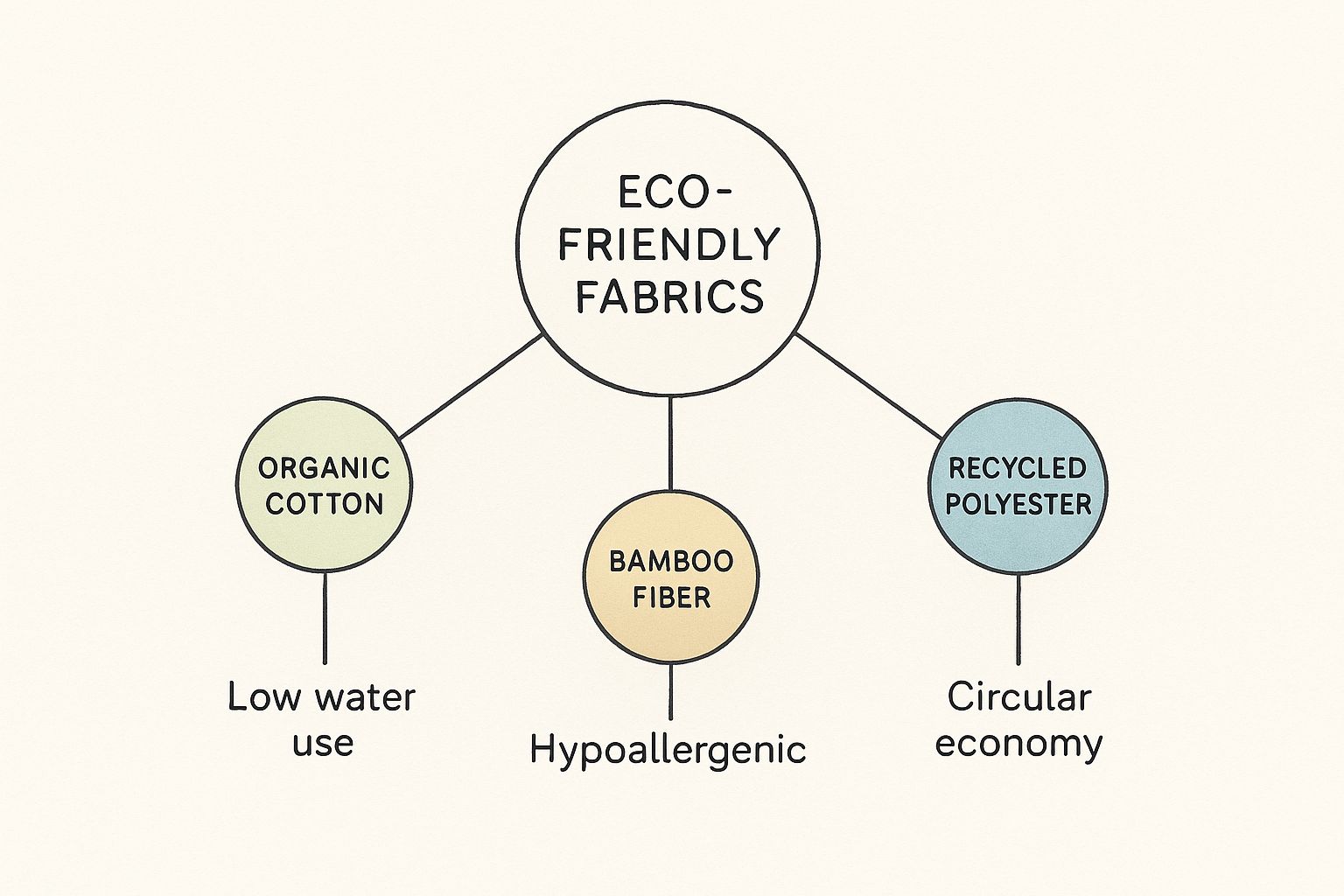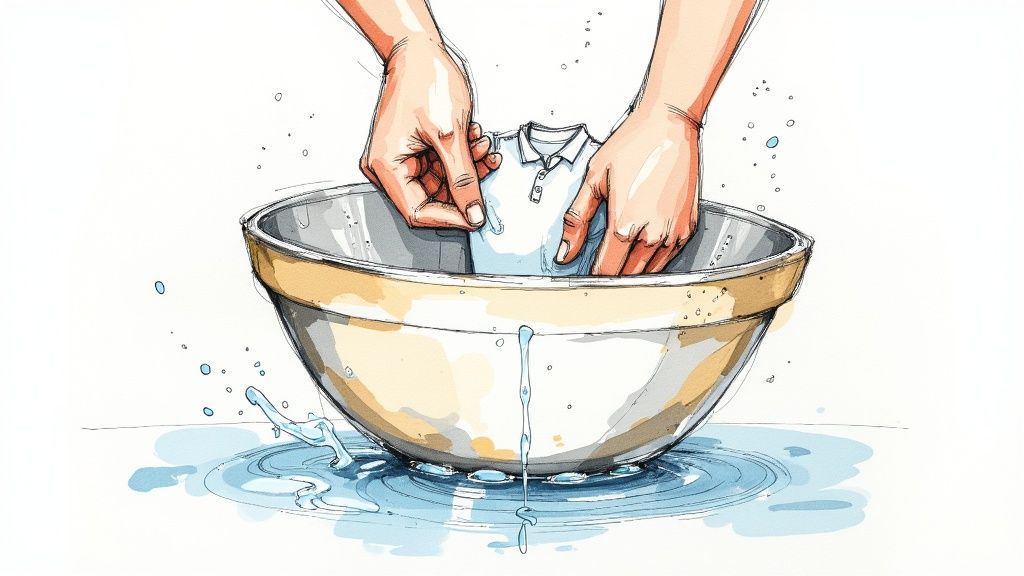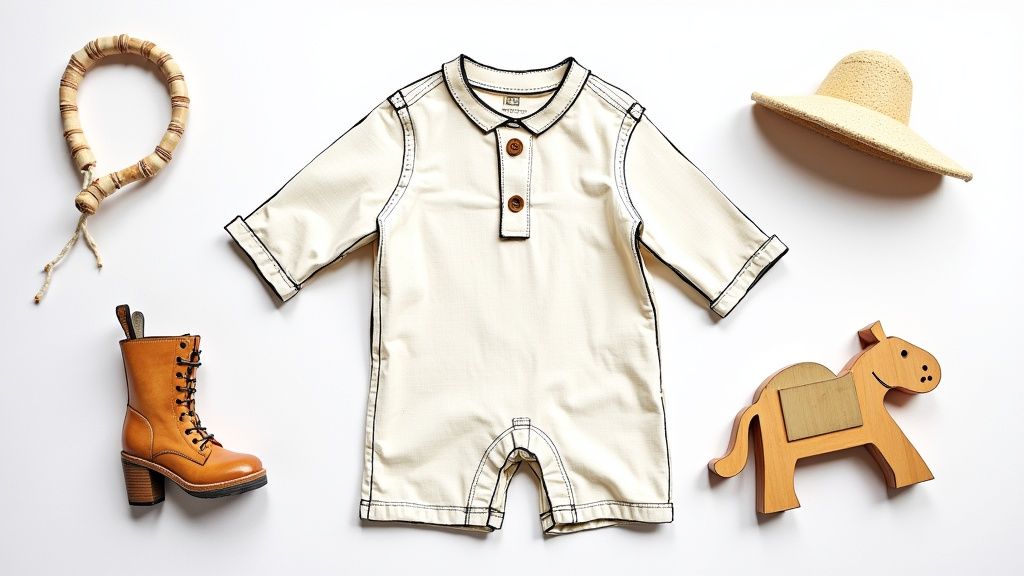More and more, parents are taking a closer look at what’s actually in their children's wardrobes. There's a definite shift away from the quick-and-cheap world of fast fashion and towards something better: eco friendly children's clothes. This isn't just about following a trend; it's a thoughtful decision for healthier children and a healthier planet, placing real value on materials that are gentle, safe, and made with care—with cotton leading the way.
Why Smart Parents Are Choosing Eco-Friendly Cotton Clothes

Think about how typical, mass-produced clothing is made. The main goal is often speed and low cost, which means cutting corners. This process frequently involves harsh chemicals, from pesticides sprayed on cotton fields to potent dyes used to create vibrant colours. Traces of these substances can easily remain in the finished garments, which is a real worry when you consider how sensitive a child's skin can be.
Eco-friendly fashion, on the other hand, is much more like tending a garden with care. It all begins with mindfully sourced materials, like soft, natural cotton, and uses processes that are safer for the makers, the planet, and of course, your little one. For parents, this provides invaluable peace of mind, knowing that their child’s clothing is free from potentially harmful residues.
The Problem with Conventional Cotton
It’s easy to think of cotton as a pure, natural fibre, but standard cotton production is surprisingly tough on the environment. It has a reputation for being incredibly thirsty and relies heavily on pesticides and synthetic fertilisers, which can seep into the soil and pollute local water supplies. This doesn't just harm the environment; it can have serious health implications for the farmers and communities growing it.
The chemicals used in conventional textile manufacturing don't just disappear. They can affect the workers who make the clothes and may even remain on the fabric that touches your child’s skin, making the switch to organic cotton a significant health choice.
This growing awareness is making waves in the UK's £7.85 billion childrenswear market. Even as overall market growth slows, the demand for sustainable options is on the rise, with parents actively searching for organic cotton. It reflects a wider movement towards prioritising both environmental ethics and children's safety, which is beginning to reshape how brands design their collections.
Making a Practical Choice
Opting for sustainable clothing isn't a sacrifice; it's a practical, positive decision for your family’s well-being and the world your children will grow up in. It’s about investing in high-quality pieces made from materials like organic cotton that are much kinder to delicate skin and the Earth. Once you understand the real benefits, you can make confident choices that truly align with your values.
This is about more than just buying clothes. It's about contributing to a better future, one soft, organic cotton onesie at a time.
Understanding Organic Cotton in Kids' Clothing
When you hear the term eco-friendly children's clothes, one material nearly always comes to mind: organic cotton. It's become the go-to fabric for so many sustainable brands, loved for its softness and breathability. But what really makes it different from the standard cotton you find everywhere on the high street?
The best way to understand the difference is to think about how they’re grown.
Conventional cotton is a bit like a massive, industrial-scale farm. The main goal is to produce as much as possible, as cheaply as possible. This often means using genetically modified (GMO) seeds that are engineered to survive heavy doses of chemical pesticides and synthetic fertilisers. While effective for high yields, this method takes a heavy toll on the environment, draining water supplies and polluting the soil and nearby rivers.
Organic cotton, on the other hand, is closer to a traditional farm that works with nature, not against it. It all starts with natural, non-GMO seeds planted in healthy, fertile soil. Farmers use age-old techniques like crop rotation and composting to keep the soil rich, which means they don't need to rely on harsh chemicals. This approach not only protects the local ecosystem and its wildlife but also shields farmers and their communities from exposure to toxic substances.
Conventional vs Organic Cotton At a Glance
To quickly see the differences side-by-side, this table breaks down the two production methods. It’s a simple way to grasp the real-world impact of choosing one over the other.
| Feature | Conventional Cotton | Organic Cotton |
|---|---|---|
| Seeds | Genetically Modified (GMO) | Natural, Non-GMO |
| Pesticides | Heavy use of synthetic chemicals | None; uses natural methods like beneficial insects |
| Fertilisers | Synthetic and chemical-based | Natural compost and manure |
| Water Usage | High consumption; often requires intensive irrigation | Significantly lower; relies more on rainwater |
| Soil Health | Degrades over time due to chemical use | Enriched through crop rotation and natural methods |
| Impact on Farmers | High exposure to toxic chemicals | Safer working conditions, no chemical exposure |
| Fabric Feel | Can be harsh due to chemical processing | Naturally softer and stronger fibres |
As you can see, the choice goes far beyond just the final garment. It’s about supporting a healthier system for the planet and the people who grow our clothes.
From Healthy Soil to Softer Fabric
The journey from a field of organic cotton to the finished fabric is a thoughtful one, focused on protecting the environment and creating a superior product. Because the soil is healthier and the plants aren't stressed by chemicals, the cotton fibres actually grow longer and stronger.
The result? A material that is noticeably softer and far more durable—which is exactly what you want for a child's sensitive skin and active lifestyle.
The benefits don't stop there. Organic farming uses dramatically less water. Some studies have shown that growing organic cotton can slash water consumption by as much as 91%. In a world where water is an increasingly precious resource, that's a massive saving.
When you choose organic cotton, you're doing more than just buying a piece of clothing. You're supporting a system that conserves water, keeps harmful chemicals out of our environment, and produces a purer, kinder material for your child. It’s a simple switch with a huge positive ripple effect.
This visual helps put it all into perspective, showing the clear benefits of choosing organic cotton.

As you can see, organic cotton stands out as a superior choice for its low environmental impact and hypoallergenic qualities, making it ideal for our kids and the planet.
Why This Matters for Your Child
Perhaps the most important benefit for any parent is what isn't in organic cotton: chemical residues. The entire process, from dyeing to finishing, is strictly regulated to ensure it's non-toxic. This is a game-changer for babies and children, especially those with skin sensitivities or conditions like eczema.
For a more in-depth look at building a non-toxic wardrobe, you might find our guide to ethical baby clothes really helpful.
At the end of the day, dressing your child in organic cotton means you're wrapping them in a fabric that's gentle, pure, and made with genuine care for both people and the planet.
How to Read Clothing Labels and Certifications

When you start your search for eco-friendly children's clothes, you’ll quickly notice a dizzying array of claims and symbols on the labels. It can feel a bit overwhelming at first. The best way to think about these labels is to compare them to the nutrition information on your food – they help you cut through the marketing fluff and get to the real story.
Just as a nutrition label tells you exactly what’s in your food, these textile certifications tell you how a garment was made. They are your most reliable guide to making truly informed choices, helping you see past vague buzzwords like "natural" or "pure". When it comes to children’s cotton clothing, there are two labels in particular that stand out as the gold standard.
GOTS: The All-in-One Guarantee for Organic Cotton
If you only remember one certification, make it this one: the Global Organic Textile Standard (GOTS). It’s the single most important seal to look for, especially on organic cotton clothing. Seeing that GOTS logo is like getting a complete quality guarantee that covers the entire journey, from the moment the cotton seed is planted right through to the finished garment on the shelf.
A GOTS certification confirms that:
- The cotton is genuinely organic: It guarantees the fabric is made from a minimum of 95% certified organic fibres, grown without nasty pesticides or genetically modified organisms.
- The processing is non-toxic: All dyes and other inputs must meet strict environmental and toxicological standards. This is absolutely vital for protecting a child's sensitive skin.
- The workers are treated fairly: GOTS also includes social criteria, ensuring safe working conditions and fair wages for everyone along the supply chain.
Essentially, GOTS is your assurance that the clothing is both ecologically clean and ethically produced. It’s the most comprehensive standard you’ll find in the textile world.
A GOTS-certified label doesn't just mean the cotton was grown organically; it confirms that every single step of the production process—from spinning and weaving to dyeing and manufacturing—was held to the highest environmental and social standards.
OEKO-TEX: Peace of Mind in the Final Product
Another crucial label to look for is OEKO-TEX STANDARD 100. While GOTS covers the whole production chain from farm to factory, OEKO-TEX focuses specifically on the safety of the final product you hold in your hands.
Think of it as the final, critical safety check. If an item of clothing has the OEKO-TEX STANDARD 100 label, it means every single component – from the thread and buttons to the fabric itself – has been thoroughly tested and proven to be free from a long list of harmful substances. This includes chemicals known to be hazardous to our health but which may not even be legally regulated yet.
For parents, this certification offers incredible peace of mind. It’s a clear signal that the clothing is safe to wear, which is especially important for items that sit directly against your child's delicate skin all day long.
The Benefits for Your Child and the Planet
When you choose eco-friendly clothes for your children, you're doing more than just picking out a cute outfit. It’s a choice that has a lovely, two-fold benefit: it’s better for your little one’s delicate skin and for the planet they’ll one day inherit. This makes sustainable fashion a genuinely rewarding decision for any parent.
The first thing you’ll probably notice is just how soft organic cotton feels. Because its fibres haven't been damaged by harsh chemicals, it's naturally softer and more breathable than the standard cotton you might be used to. For children with sensitive skin or conditions like eczema, this can be a real game-changer, helping to minimise irritation and keep them comfy all day.
There's also incredible peace of mind in knowing you're dressing your child in purer materials. When you choose clothes made from organic cotton without toxic dyes and pesticide residues, you're wrapping them in something genuinely clean and safe.
A Healthier Planet for Them to Explore
The positive impact of these choices stretches far beyond your own home. Buying eco-friendly clothes, especially those made from organic cotton, is a direct contribution to a healthier environment.
Here’s a look at how each small purchase adds up to a big difference:
- Saving Water: Organic farming methods can slash water consumption by up to 91% compared to conventional cotton farming. That's a huge saving of a truly precious resource.
- Cleaner Waterways: By sidestepping synthetic pesticides and fertilisers, organic farms stop harmful chemicals from running off into our rivers and oceans, which helps protect aquatic life.
- Richer Soil: Sustainable practices like crop rotation and composting naturally build up the soil. This boosts biodiversity and keeps the land fertile for generations to come.
Every time you choose an organic cotton garment, you are casting a vote for a more sustainable system. You're supporting farming methods that protect ecosystems and ensure cleaner air, water, and soil for everyone.
Of course, it's not just about one t-shirt. The commitment from brands and shoppers is what really drives change. Taking a moment for understanding broader sustainability efforts helps put the power of our collective choices into perspective.
Ultimately, dressing your child in eco-friendly clothing is an investment. It’s an investment in their immediate comfort and well-being, and in the long-term health of our planet. It’s a beautiful way to show you care, one soft, thoughtfully made garment at a time.
Top UK Brands for Eco-Friendly Cotton Clothes

Trying to shop sustainably can feel overwhelming, but the good news is you don’t have to do all the legwork yourself. A handful of fantastic UK brands have already done the hard part, making it simple to find clothes that align with your values. These companies are proving you don't need to sacrifice style or durability for sustainability, making the switch to eco-friendly children's clothes a joy rather than a chore.
At the heart of their collections, you'll find high-quality, GOTS-certified organic cotton. This commitment means every piece is incredibly soft, completely safe for sensitive skin, and made with genuine respect for both the planet and the people involved in its creation.
Frugi: A Celebration of Colour and Conscience
When you think of fun, vibrant, and sustainable kids' clothes in the UK, Frugi is a name that instantly springs to mind. They’ve built a beloved brand around bright, playful designs that kids absolutely love to wear. Just as importantly, their dedication to ethical production is every bit as strong as their colourful patterns.
Every single garment is made from buttery-soft, GOTS-certified organic cotton, ready for any adventure. But what parents really appreciate are the clever, practical details. Many Frugi pieces come with features like adjustable waistbands or extendable cuffs, so the clothes grow alongside your child. This thoughtful design means they last far longer than your average high-street buy, making them a brilliant, sustainable investment.
Other Brands Championing Organic Cotton
The shift towards greener kids' fashion is really picking up steam across the UK. It's clear that growing environmental awareness is changing how we shop, and the market is responding. This isn't just about Frugi; you also have brilliant brands like Toby Tiger, another pioneer known for its bold and cheerful organic cotton clothes.
We're even seeing major business moves that point to a bigger industry trend. For instance, the recent acquisition of recycled cashmere brand Turtle Doves by Refined Brands (which already owns Frugi) shows a clear corporate commitment to ethical materials. It's moves like these that are cementing the UK’s reputation as a hub for responsible fashion. If you're interested, you can read more about the growing organic apparel market to see just how much consumer demand is shaping the industry for the better.
By choosing brands that prioritise organic cotton and transparent practices, you are directly supporting a kinder, cleaner, and more ethical approach to fashion. It’s a powerful way to vote with your wallet for the future you want for your children.
These brands prove that dressing your kids in beautiful, high-quality clothes doesn’t have to come at the planet's expense.
Frequently Asked Questions
When you first start looking into eco-friendly clothes for your little ones, it’s completely normal to have questions. It can feel like a whole new world. Parents often wonder about the cost, how to look after the clothes, and if it’s all really worth it. Let’s tackle some of those common queries about organic cotton clothing head-on with clear, practical answers to help you feel confident about your choices.
Is Organic Cotton Clothing Really Worth the Higher Price?
It’s no secret that a certified organic cotton garment usually costs more than a conventional one. But it helps to see it as an investment, not just an expense. That higher price tag is a direct reflection of the much higher standards upheld every step of the way, from the farm to the finished item.
What are you actually paying for?
- Safer Farming: Farmers aren’t exposed to toxic pesticides, which means better health for them, their families, and their local communities.
- Purer Materials: With no harsh chemicals or toxic dyes, you get a cleaner, incredibly soft fabric that’s much kinder to your child’s delicate skin.
- Superior Durability: Because organic cotton fibres haven’t been weakened by harsh chemical processing, they’re naturally longer and stronger. This means the clothes last longer, keep their shape, and can be handed down to siblings or friends, giving you far better value in the long run.
So, while the initial cost might be a bit more, the long-term gains for your child's health, the planet, and the sheer longevity of the garment make it a choice many families feel good about.
How Should I Care for Organic Cotton Clothes to Make Them Last?
One of the best things about well-made organic cotton is just how sturdy it is. With the right care, you can make it last even longer, keeping every piece looking fantastic. The great news? It doesn’t involve any complicated laundry routine. A few simple tweaks are all it takes.
To get the most out of your eco-friendly children’s clothes:
- Wash in Cold Water: A cool wash cycle (30°C is perfect) is not only better for the planet but also much gentler on the fabric's natural fibres and colours.
- Use a Mild Detergent: Choose a gentle, eco-friendly detergent without any harsh chemicals, phosphates, or chlorine. This helps keep the fabric soft and is a much better choice for sensitive skin.
- Line Dry When Possible: Tumble dryers are rough on clothes, often causing shrinkage and weakening the fibres over time. Letting them air dry is the kindest option and will help the garment keep its original shape and feel.
Follow these simple steps, and you’ll keep those beautiful organic cotton pieces soft, vibrant, and ready for adventure after adventure.
Will My Kids Just Ruin Expensive Eco-Friendly Clothes?
Every parent has had this thought! It’s a completely valid concern. Kids are practically professionals at getting messy, and the idea of a huge grass stain on a lovely, pricier outfit is enough to make anyone nervous. But here’s the thing: durability is one of the biggest strengths of high-quality organic cotton clothing.
The natural strength of organic cotton fibres means they can often withstand more wear and tear than conventional cotton. Plus, investing in fewer, higher-quality pieces can shift your mindset from disposable fashion to clothing that's worth caring for.
It's also about being practical. You don't need to wrap them in cotton wool or save these clothes only for 'best'. Many parents find a happy medium—using them for everyday wear at home or for calmer outings, while maybe saving older or second-hand items for those really messy park days. At the end of the day, these clothes are designed for children to live, play, and be themselves in.
Are There Options for Parents on a Tighter Budget?
Absolutely. Going sustainable isn't an all-or-nothing game, and it’s certainly not just for people with big budgets. There are plenty of smart, savvy ways to build a wonderful eco-friendly wardrobe for your child without it costing the earth.
Here are a few practical ideas to get you started:
- Shop Second-Hand: Charity shops, nearly-new sales, and online marketplaces are absolute goldmines for high-quality, pre-loved children’s clothes.
- Prioritise Key Pieces: If you're starting out, focus on investing in the items that get the most wear and have the most contact with your child’s skin, like organic cotton bodysuits, pyjamas, and vests.
- Embrace Hand-Me-Downs: Say yes to clothes from friends and family, and be sure to pass yours on too. This is sustainability in its purest form!
- Create a Capsule Wardrobe: Try to buy fewer, more versatile, high-quality pieces that can all be mixed and matched. You’ll be surprised at how few items you actually need.
By trying a few of these strategies, you can make sustainable choices that feel right for your family, your values, and your budget.
At Little Novice, we believe in creating timeless, minimalist pieces from natural fabrics like organic cotton that are made to last. Our collections offer a thoughtful alternative to fast fashion, focusing on quality and comfort so you can build a beautiful, sustainable wardrobe for your child with confidence. Explore our collection at https://littlenovice.co.uk.